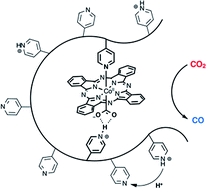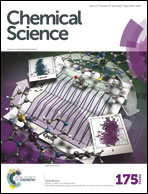Polymer coordination promotes selective CO2 reduction by cobalt phthalocyanine†
Abstract
Cobalt phthalocyanine (CoPc) is a known electrocatalyst for the carbon dioxide reduction reaction (CO2RR) that, when adsorbed onto edge-plane graphite (EPG) electrodes, shows modest activity and selectivity for CO production along with co-generation of H2. In contrast, electrodes modified with CoPc immobilized in a poly-4-vinylpridine (P4VP) film show dramatically enhanced activity and selectivity compared to those modified with CoPc alone. CoPc-P4VP films display a faradaic efficiency of ∼90% for CO, with a turnover frequency of 4.8 s−1 at just −0.75 V vs. RHE. Two properties of P4VP contribute to enhancing the activity of CoPc: (1) the ability of individual pyridine residues to coordinate to CoPc and (2) the high concentration of uncoordinated pyridine residues throughout the film which may enhance the catalytic activity of CoPc through secondary and other outer coordination sphere effects. Electrodes modified with polymer-free, five-coordinate CoPc(py) films (py = pyridine) and with CoPc catalysts immobilized in non-coordinating poly-2-vinylpyridine films were prepared to independently investigate the role that each property plays in enhancing CO2RR performance of CoPc-P4VP. These studies show that a synergistic relationship between the primary and outer coordination sphere effects is responsible for the enhanced catalytic activity of CoPc when embedded in the P4VP membrane.

- This article is part of the themed collection: Global Energy Challenges: Fossil Fuels


 Please wait while we load your content...
Please wait while we load your content...